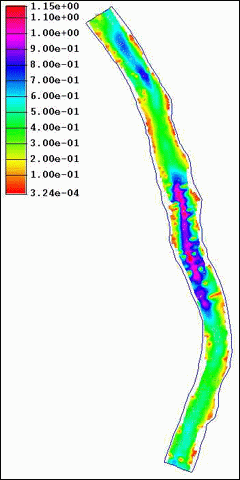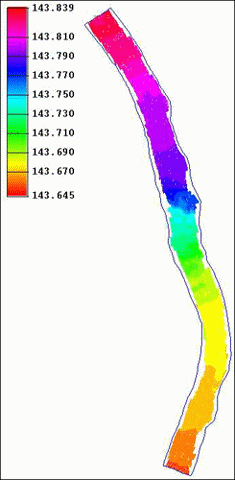Overview of an Instream Hydraulic Simulation Methodology
(Past Method for Instream Flow Modeling)
Go to Present Instream Flow Program
Hydraulic modeling is conducted to simulate the changing hydraulic
characteristics of a stream study segment at various flow rates. Variations in hydraulic character may then be related to the speciesí hydraulic
preferences and used to assess speciesí habitat availability. Since this type of study focuses on low flow conditions, hydraulic simulations
are typically performed at several flow rates below the median flow
(fifty percentile flow frequency).
Mathematical Model Hydraulic characteristics of the river segments
are assessed using a two dimensional (2-D) depth-averaged finite-element
model. A steady state numerical solution is developed for each flow
rate of interest. SMS
and RMA2
can be used for grid creation and simulation. This hydraulic simulation model is
valid for shallow surface water flow problems such as for rivers and
estuaries. The advantages of using this type of model are (1) ability
to simulate complex 2-D flow conditions such as eddy currents and backwater
flow, and (2) ability to handle complex bathymetry such as braided channels,
tributary islands, and sand/gravel bars.
Model Boundary Conditions Hydraulic model boundary conditions
are defined as the upper or up-stream discharge and the lower or down-stream
water surface elevation. An example discharge versus water surface elevation
relation (stage-discharge curve) is shown above.
Model Calibration In addition to the stage curves developed for
the downstream boundary of the stream study segment, velocity and depth
measurements are collected and compared to simulated values. In the
figures shown below simulated water velocity and water surface elevation
contour plots are presented for a typical study reach.
Simulated Velocity Contour Plot

Simulated Water Surface
Elevation Contour Plot

Click
here to download HYDROSTAT software.
|
For more information, please contact:
Gayla Ray - Surface Water Resources
Telephone: (512) 936-0817
|
SMS software
is a product of:
Brigham Young University
Engineering Graphics Laboratory
368B CB
Provo, Utah 84602
(801)378-2812
FAX (801)378-2478
http://www.ecgl.byu.edu
For information on RMA2:
US Army Corps of Engineers
Waterways Experimental Station Hydraulics Laboratory
http://hlnet.wes.army.mil
|

